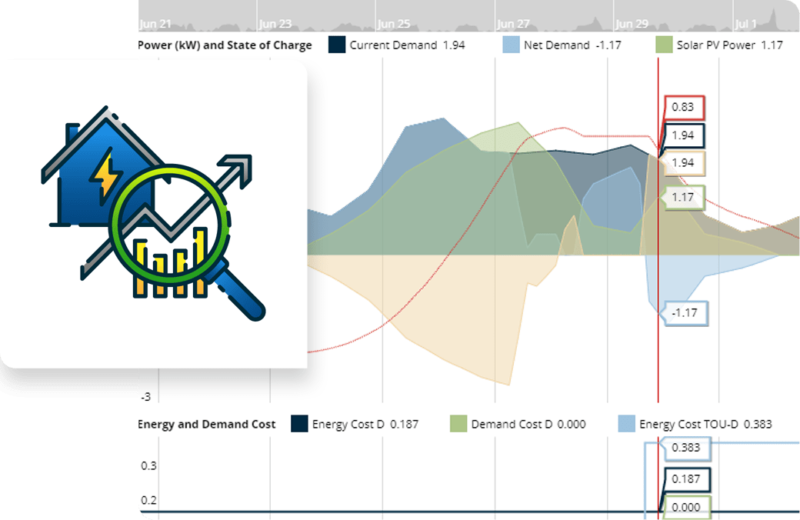Assessing Your Energy Needs:
A Crucial Step for Effective Solar Energy Modelling

Recognizing and assessing your energy needs is a vital precursor to solar energy modelling. It allows businesses to devise a tailored system that aligns with their specific energy patterns and maximizes self-consumption.
This article discusses the intricate aspects of energy needs assessment, including grid consumption analysis and load profile evaluation, to illustrate how these elements fortify the foundation for efficient solar energy modelling for effective Commercial Solar.
1. Grid Consumption Analysis:
The Cornerstone of Solar Energy Modelling
At the heart of Commercial Solar energy modelling lies grid consumption analysis. This process involves a detailed examination of your current electricity usage, delving into aspects like total energy consumed, peak demand times, and seasonal variations. Comprehensive grid consumption analysis is instrumental in creating an accurate solar energy model, as it provides insights into the quantity and timing of energy usage.
Analyzing monthly utility bills over a year can yield a wealth of information. It uncovers patterns in energy consumption and highlights periods of high usage, thereby helping determine the optimal size of the system. Accurate grid consumption analysis, therefore, forms the cornerstone of effective solar energy modelling.
2. Load Profile Analysis:
Mapping Energy Consumption Patterns
Load profile analysis is another vital component of Commercial Solar energy modelling. A load profile essentially maps your energy consumption patterns over a specific period, usually 24 hours. It charts the variation in energy demand throughout the day, providing valuable insights into peak demand times and durations of low usage.
Understanding the load profile is paramount to maximizing solar self-consumption. Solar panels produce the most energy during midday when the sun is at its peak. However, for many businesses, peak energy demand does not necessarily align with peak solar production. Load shifting strategies, such as rescheduling energy-intensive operations to coincide with solar production peaks, can be developed from a detailed load profile. This aligns energy demand with solar production, enhancing solar self-consumption and reducing reliance on grid-supplied electricity.
3. Solar Production and Self-Consumption:
The Desired Outcome of Solar Energy Modelling
The ultimate aim of solar energy modelling is to increase self-consumption of Commercial Solar Systems. Solar self-consumption refers to the percentage of solar energy generated that is consumed directly by your business. A higher solar self-consumption rate translates into less reliance on the grid, resulting in substantial cost savings.
Assessing your energy needs through grid consumption analysis and load profile examination facilitates accurate solar energy modelling. It allows businesses to size their solar power system appropriately, reducing the potential for energy wastage. Moreover, it enables them to strategically align their energy demand with solar production, significantly increasing their solar self-consumption.
4. Leveraging Technology for Solar Energy Modelling
Advanced software solutions now exist to aid in solar energy modelling. These tools utilize consumption data to simulate the performance of the system and calculate potential energy savings. By integrating weather data, they can also account for seasonal variations in solar production.
These software tools streamline the process of Commercial Solar energy modelling, providing businesses with accurate predictions of system performance and potential cost savings. It is, however, crucial to ensure that the data fed into these tools is accurate and comprehensive, underscoring the importance of thorough grid consumption analysis and load profile assessment.
5. Assessing Energy Needs – An Imperative for Optimal Solar Energy Modelling
In conclusion, the meticulous assessment of energy needs through comprehensive grid consumption analysis and detailed load profile evaluation forms the cornerstone of effective solar energy modeling. This deep understanding facilitates the precise design and implementation of commercial Solar and Battery Systems that align seamlessly with specific business energy usage patterns. By doing so, companies can maximize solar self-consumption and optimize cost savings, notably impacting the overall Solar and Battery Price.
Harnessing the power of solar energy commences with an in-depth comprehension of your energy needs, marking an essential step towards a sustainable and economically efficient future. The strategic integration of solar and battery systems is fundamental in realizing these efficiencies, underpinning the transition to a more resilient and cost-effective energy framework.
 1300 880 890
1300 880 890